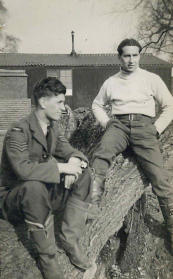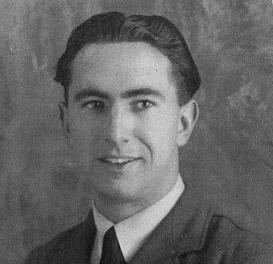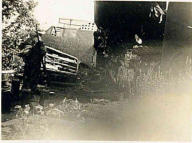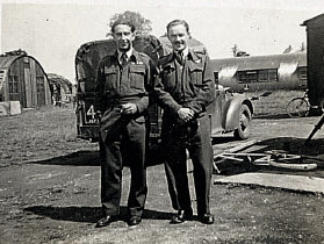

RAF Hunsdon Air & Ground Crew Stories 3
Flt. Lt. Thomas Gibbs
We
focus
on
another
Hunsdon
pilot
and
crew,
Sgt.
Thomas
Gibbs
and
his
Radio
Observer,
Sgt.
Maurice
Stanley
'Jack'
Waller.
Sgt.
Gibbs,
who
liked
to be known as 'Tommy', flew Douglas DB-7 Havoc AI equipped night fighters with 85 Squadron at Hunsdon from 1941 to 1942.
Thomas
Alfred
Gibbs
was
born
on
the
9th
December
1920
in
Ipswich,
Suffolk
and
later
went
to
school
at
Northgate
Grammar
School.
Tommy
was
also
a
member
of
the
choir
at
St
John's
Church
in
Cauldwell
Hall
Road.
He
also
played
football
for
the
choir
team
and
played
rugby
for
the
Ipswich
Y.M.C.A.
A
boy
of
many
talents,
he
learned
to
sail
with
the
13th
Ipswich
Sea
Scout
Group,
where
he
attained
his
King’s
Scout
Badge
in
1936.
He
loved
sailing,
later
ending
up
with
a
Benghazi
Sailing
Club
Helmsman's
Certificate
after
the
War.
He
also
enjoyed
cycling
and
that
included
cycling
holidays
in
Britain,
and
swimming,
for
which
he
held
several
certificates,
both
in
lifesaving
and
general
swimming.
He
was
very
interested
in
wildlife,
nature
of
all
types and he played piano!
After
schooling
ended
at
the
age
of
fifteen,
he
worked
for
Ransomes
in
Ipswich
as
a
Pay
Clerk
in
the
Engineering
Dept.
He
joined
the
RAF
in
1940
and
was
posted
on
the
27th
September
1940
to
No
6
Initial
Training
Wing,
Aberystwyth.
This
was
a
converted
Hotel
and
the
pupils
were
taught
the
necessities
of
service
life
and
Pilots’
ground
schooling
for
eight
weeks.
For
actual
flying
training,
he
was
posted
to
7
Elementary
Flying
Training
School at Royal Air Force Desford in Leicestershire, where he learned to fly de Havilland Tiger Moths.
This
was
usually
a
ten
week
course.
He
went
solo
on
January
5th,
1941.
Another
posting
was
to
No15
S.F.T
S.
at
Kidlington,
Oxford
for
a
further
sixteen
weeks
on
twin-engine
Airspeed
Oxfords
with
No.
2
Training
Squadron.
Tommy
was
then
posted
to
54
Operational
Training
Unit
at
Church
Fenton, Yorkshire. This was a dedicated night fighter school as such, utilising and flying in several types of aircraft, including Bristol Blenheims.
After
gaining
his
Pilot’s
Wings,
he
was
posted
to
85
Squadron,
who
were
based
at
the
newly
built
RAF
Hunsdon
on
the
outskirts
of
Ware
in
Hertfordshire.
85
Squadron
were
a
noted
RAF
Fighter
Squadron
who
had
fought
in
the
Battle
of
France
and
the
Battle
of
Britain
with
distinction.
Now
in
a
Night
Fighter
role,
they
were
the
flying
twin
engine
Douglas
DB-7
Havoc,
a
light
bomber
converted
for
night
fighter/Intruder
use
and
equipped
with
AI Mk IV radar sets. It carried a two man crew, Pilot and Radio/Observer, and was armed with eight .303in Browning Machine Guns.
It
was
probably
here
or
just
after
finishing
flight
training
that
he
teamed
up
with
his
own
Navigator/
Observer,
Sgt.
Jack
Waller.
They
flew
as
a
regular
crew
for
several
months
with
no
success.
The
German
night
raids
on
London
had
tailed
off
and
all
of
the
crews
were
busy
flying
practice
sorties
in
an
effort
to
hone
their
skills.
Several
enemy
aircraft
were
engaged
and suffered damage during normal patrols at this time, but no notable successes were reported.
On
the
26
January
1942,
Sgt.
Gibbs,
Sgt.
Waller
and
another
Radio
Observer,
Sgt.
Molds,
were
detailed
to
sail
on
a
Convoy
Escort
Ship
from
Sheerness
in
Kent
to
observe
how
convoys
were
protected
by
the
anti-aircraft
guns
of
the
escorts.
They
sailed
as
far
as
the
Firth
of
Forth
in
Scotland
with
a
convoy
but
did
not
see
any
enemy
aircraft.
However,
apparently
the
trio
were
treated
to
having
a
go
at
firing
the
multiple
barrelled
40mm
pom
pom
guns
of
the
escort
ship...and
were suitably entertained in the wardroom by the ship’s officers and crew.
On
the
night
of
the
10th
of
April
1942,
Tommy
and
Jack
were
returning
to
RAF
Hunsdon
during
stormy
weather
and
the
Havoc
aircraft
they
were
flying
that
night
suffered
a
front
nose
wheel
collapse
on
landing.
The
crew
was
unhurt
and
the
aircraft suffered only superficial damage.
Snow at RAF Hunsdon in 1941. The 'Saint' circles above some of the names in his album
denote those who were killed later while on 'ops' with the RAF.
RAF Hunsdon's dH Tiger Moth. Roy Tinkler(left) and Tommy. A photo taken after the 'prang'
A Station 'Hack' (a reference to the nosewheel collapse.)
Some images of Life at RAF Hunsdon 1941 -1942
On
the
night
of
the
2/3rd
June
1942
aircraft
were
patrolling
off
the
Essex
coast
after
a
second
'Baedeker'
raid
consisting
of
25
German
bombers
was
reported
attacking
Canterbury,
Kent.
Flt/Lt.
Maude,
also
from
85
Squadron,
engaged
a
'hostile'
and
claimed
it
as
shot
down
and
destroyed,
but
at
that
exact
time
Sgt.
Gibbs
and
Sgt.
Waller
were
patrolling
the
same
area
in
Havoc
VY-D
off
the
coast
looking
for
these
German
raiders
when
they
were
attacked
by
an
unknown
aircraft
and
were
badly
hit.
Sgt.
Gibbs
managed
to
bail
out
safely
but
was
adrift
for
eight
hours
in
a
single
seat
'K'
dinghy
before
being
rescued
by
an
Air
Sea
Rescue
Supermarine
Walrus
amphibious
seaplane.
This
was
flown
by
former
Battle
of
Britain
pilot,
Flt.
Sgt.
Stillwell,
DFM,
and
his
crew
members,
Sgt.
Markey
and
Flt.
Sgt.
Pickles.
He
landed
safely
at
RAF
Martlesham
Heath.
Unfortunately,
Sgt.
Maurice
Stanley
'Jack'
Waller's
body
was
washed
up
the
next
day
at
Burnham
on
Crouch.
Tommy
Gibbs
was
in
hospital
for
several
days
and
missed
his
Radio/Observer’s funeral at Lowestoft.
Flt/Lt.
Maude
had
had
previous
incidents
while
flying
the
squadron’s
aircraft.
On
the
21st
August
1941,
he
selected
'wheels
up'
instead
of
the
flaps
while
he
was
on
the
ground
and
the
aircraft
collapsed
in
a
heap.
Later
the
same
day
in
another
of
the
squadron’s
Havocs,
he
overshot
the
runway
while attempting to land in bad weather and crash landed the aircraft.
For surviving a crash at sea, Tommy was awarded membership of the Goldfish Club.This Badge and the notification letter Hang at his Daughters
home
Sgt.
Tommy
Gibbs
returned
to
the
Squadron
at
Hunsdon
on
the
7th
June
1942.
Just
under
a
month
later,
he
was
involved
in
another
incident
while
landing
at
Hunsdon
in
another
Havoc.
This
time
his
Radio
/Observer
was
Flight
Sergeant
Franklin.
They
had
been
airborne
for
over
two
hours
that
night
when
the
aircraft
started
to
develop
trouble
with
its
starboard
engine,
Sgt.
Gibbs
decided
to
head
back
to
Hunsdon
and
while
in
the
overhead
circuit,
the
errant
engine
decided
to
pack
up
completely.
While
heading
into
the
threshold
for
the
main
runway
at
the
Acorn
Street
end
of
the
main
runway,
the
aircraft
could
not
maintain
its
height,
catching
the
port
wing
on
a
barn
at
Spellers
Farm,
spinning
the
aircraft
around,
coming
to
rest
in
a
prize
plum
tree,
part
of
an
orchard
attached
to
No.
2
Spellers
Cottages,
Hunsdon.
Both
the
crew
climbed
out
unhurt
and
the
bedroom
window
of
the
cottage was flung open by the resident, Mr. Jordan, and he then set about berating the crew for knocking down his prized fruit tree!
He
resumed
flying
on
9th
June
with
F/O
Bunting
as
Radio
Observer
but
also
flew
with
other
R/Os
including
a
Sgt.
Macdonald,
Sgt.
Vane,
F/LT.
Murphy,
Cpl.
Mooney,
L.A.C.
Roy
and
F/O
Dougal
and
Branse
Burbidge,
who
would
eventually
become
the
top
scoring
RAF
night
fighter
pilot,
Tommy
and
he
had
flown
together
on
occasions.
Tommy
finally
teamed
up
with
Flight/Sgt.
Franklin
(Frankie)
for
the
first
time
on
25th
June
1942.
They
are
mostly
flying
a
Havoc
II
that
was
coded
VY-D.
On
the
14th
August
1942
he
flew
with
W/Cdr.
Raphael,
now
85
Squadron’s
Commanding
Officer,
to
RAF Northolt and returned.
Sgt.
Tommy
Gibbs
last
flew
from
RAF
Hunsdon
on
the
9th
September
1942
to
RAF
Cranfield
following
his
posting
to
No.
51
O.T.U.
Here
he
became
an
instructor
and
was
then
posted
to
No.
3
Flying
Instructors
School,
Hullavington
from
16th
October
1942.
Further
postings
took
him
and
Sgt.
Franklin
to
No.
1
Squadron
Twinwood
Farm,
Bedford
teaching
American
pilots
night
flying.
Then
he
was
posted
to
No.
4
Squadron
Cranfield
again
teaching
U.S.A.A.F
pilots.
On
the18th
April
1942
he
resumed
combat
flying
with,
25
Squadron
at
Church
Fenton,
flying
de
Havilland
Mosquitoes
with
'Frankie' Franklin, now a Flying Officer.
Tommy & Frankie Franklin
The
entries
in
his
RAF
Pilot's
Flying
Log
Book
are
dated
from
15th
September
1940
to
the
2nd
February
1946
but
the
last
entry
flying
for
the
Royal
Air
force is dated on the 28th August 1944.
This
is
when
he
joined
British
Overseas
Airways
at
Whitchurch
flying
Dakotas.
He
stayed
with
that
organisation
as
it
later
became
British
European
Airways
and
later
still
British
Airways
until
his
retirement.
It
was
on
the
12th
September
1945,
when
he
joined
the
newly
created
British
European
Airways.
This
was
born
out
of
the
formation
of
BOAC
and
he
was
one
of
the
first
airline
captains
to
carry
out
proving
flights
for
the
airline.
British
European Airways (BEA) started operations on 1st August 1946 from the ex-wartime airfield of Northolt just to the west of London.
It
began
flying
by
using
a
fleet
of
Vickers
Viking
airliners.
After
training,
he
flies
routes
to
Lisbon,
Gibraltar,
Castel
Benito,
Almaza,
Istres,
El
Adem,
Cairo,
Elmas,
Sardinia,
Luqa,
Gothenburg
and
Bordeaux.
He
had
his
first
trip
as
Captain
in
Charge
on
the
1st
June
1945.
He
flew
Vanguards,
Viscounts, Comets and Tridents, becoming a Senior Captain and on two occasions flew inaugural flights to Marrakech and Toulouse.
Tommy Gibbs sadly passed away on 16th April 2011, aged 90.
With extreme thanks to the family of Tommy Gibbs for allowing me to publish these photographs here with their permission.
These
photographs
have
not
been
published
anywhere
else,
As
a
special
caveat,
I
ask
that
under
no
account
are
these
images
to
be
copied
and
posted
anywhere
else
digitally
or
otherwise,
This
especially
includes
Facebook
pages
where
photos
from
this
site
somehow
'appear',
and
Wikipedia
pages. They remain the strict copyright of Paula Masters.
All Photographs on this page are owned by and are the copyright of Paula Masters.



















Wartime Airfields
rjkdesign
Wartime Airfields
rjkdesign


Wartime Airfields
Wartime Airfields
RAF Hunsdon Airfield Site


RAF Hunsdon Air & Ground Crew Stories 3
Flt. Lt. Thomas Gibbs
We
focus
on
another
Hunsdon
pilot
and
crew,
Sgt.
Thomas
Gibbs
and
his
Radio
Observer,
Sgt.
Maurice
Stanley
'Jack'
Waller.
Sgt.
Gibbs,
who
liked
to
be
known
as
'Tommy',
flew
Douglas
DB-7
Havoc
AI
equipped
night fighters with 85 Squadron at Hunsdon from 1941 to 1942.
Thomas
Alfred
Gibbs
was
born
on
the
9th
December
1920
in
Ipswich,
Suffolk
and
later
went
to
school
at
Northgate
Grammar
School.
Tommy
was
also
a
member
of
the
choir
at
St
John's
Church
in
Cauldwell
Hall
Road.
He
also
played
football
for
the
choir
team
and
played
rugby
for
the Ipswich Y.M.C.A.
A
boy
of
many
talents,
he
learned
to
sail
with
the
13th
Ipswich
Sea
Scout
Group,
where
he
attained
his
King’s
Scout
Badge
in
1936.
He
loved
sailing,
later
ending
up
with
a
Benghazi
Sailing
Club
Helmsman's
Certificate
after
the
War.
He
also
enjoyed
cycling
and
that
included
cycling
holidays
in
Britain,
and
swimming,
for
which
he
held
several
certificates,
both
in
lifesaving
and
general
swimming.
He
was
very
interested in wildlife, nature of all types and he played piano!
After
schooling
ended
at
the
age
of
fifteen,
he
worked
for
Ransomes
in
Ipswich
as
a
Pay
Clerk
in
the
Engineering
Dept.
He
joined
the
RAF
in
1940
and
was
posted
on
the
27th
September
1940
to
No
6
Initial
Training
Wing,
Aberystwyth.
This
was
a
converted
Hotel
and
the
pupils
were
taught
the
necessities
of
service
life
and
Pilots’
ground
schooling
for
eight
weeks.
For
actual
flying
training,
he
was
posted
to
7
Elementary
Flying
Training
School
at
Royal
Air
Force
Desford
in
Leicestershire, where he learned to fly de Havilland Tiger Moths.
This
was
usually
a
ten
week
course.
He
went
solo
on
January
5th,
1941.
Another
posting
was
to
No15
S.F.T
S.
at
Kidlington,
Oxford
for
a
further
sixteen
weeks
on
twin-engine
Airspeed
Oxfords
with
No.
2
Training
Squadron.
Tommy
was
then
posted
to
54
Operational
Training
Unit
at
Church
Fenton,
Yorkshire.
This
was
a
dedicated
night
fighter
school
as
such,
utilising
and
flying
in
several
types
of
aircraft,
including
Bristol Blenheims.
After
gaining
his
Pilot’s
Wings,
he
was
posted
to
85
Squadron,
who
were
based
at
the
newly
built
RAF
Hunsdon
on
the
outskirts
of
Ware
in
Hertfordshire.
85
Squadron
were
a
noted
RAF
Fighter
Squadron
who
had
fought
in
the
Battle
of
France
and
the
Battle
of
Britain
with
distinction.
Now
in
a
Night
Fighter
role,
they
were
the
flying
twin
engine
Douglas
DB-7
Havoc,
a
light
bomber
converted
for
night
fighter/Intruder
use
and
equipped
with
AI
Mk
IV
radar
sets.
It
carried
a
two
man
crew,
Pilot
and
Radio/Observer,
and
was
armed
with
eight
.303in
Browning
Machine Guns.
It
was
probably
here
or
just
after
finishing
flight
training
that
he
teamed
up
with
his
own
Navigator/
Observer,
Sgt.
Jack
Waller.
They
flew
as
a
regular
crew
for
several
months
with
no
success.
The
German
night
raids
on
London
had
tailed
off
and
all
of
the
crews
were
busy
flying
practice
sorties
in
an
effort
to
hone
their
skills.
Several
enemy
aircraft
were
engaged
and
suffered
damage
during
normal
patrols
at
this
time,
but
no
notable
successes
were
reported.
On
the
26
January
1942,
Sgt.
Gibbs,
Sgt.
Waller
and
another
Radio
Observer,
Sgt.
Molds,
were
detailed
to
sail
on
a
Convoy
Escort
Ship
from
Sheerness
in
Kent
to
observe
how
convoys
were
protected
by
the
anti-aircraft
guns
of
the
escorts.
They
sailed
as
far
as
the
Firth
of
Forth
in
Scotland
with
a
convoy
but
did
not
see
any
enemy
aircraft.
However,
apparently
the
trio
were
treated
to
having
a
go
at
firing
the
multiple
barrelled
40mm
pom
pom
guns
of
the
escort
ship...and
were
suitably entertained in the wardroom by the ship’s officers and crew.
On
the
night
of
the
10th
of
April
1942,
Tommy
and
Jack
were
returning
to
RAF
Hunsdon
during
stormy
weather
and
the
Havoc
aircraft
they
were
flying
that
night
suffered
a
front
nose
wheel
collapse
on
landing.
The crew was unhurt and the aircraft suffered only superficial damage.
Snow at RAF Hunsdon in 1941. The 'Saint' circles above some of the
names in his album denote those who were killed later while on 'ops'
with the RAF.
Some images of Life at RAF Hunsdon 1941 -1942
On
the
night
of
the
2/3rd
June
1942
aircraft
were
patrolling
off
the
Essex
coast
after
a
second
'Baedeker'
raid
consisting
of
25
German
bombers
was
reported
attacking
Canterbury,
Kent.
Flt/Lt.
Maude,
also
from
85
Squadron,
engaged
a
'hostile'
and
claimed
it
as
shot
down
and
destroyed,
but
at
that
exact
time
Sgt.
Gibbs
and
Sgt.
Waller
were
patrolling
the
same
area
in
Havoc
VY-D
off
the
coast
looking
for
these
German
raiders
when
they
were
attacked
by
an
unknown
aircraft
and
were
badly
hit.
Sgt.
Gibbs
managed
to
bail
out
safely
but
was
adrift
for
eight
hours
in
a
single
seat
'K'
dinghy
before
being
rescued
by
an
Air
Sea
Rescue
Supermarine
Walrus
amphibious
seaplane.
This
was
flown
by
former
Battle
of
Britain
pilot,
Flt.
Sgt.
Stillwell,
DFM,
and
his
crew
members,
Sgt.
Markey
and
Flt.
Sgt.
Pickles.
He
landed
safely
at
RAF
Martlesham
Heath.
Unfortunately,
Sgt.
Maurice
Stanley
'Jack'
Waller's
body
was
washed
up
the
next
day
at
Burnham
on
Crouch.
Tommy
Gibbs
was
in
hospital
for
several
days
and
missed
his
Radio/Observer’s
funeral at Lowestoft.
Flt/Lt.
Maude
had
had
previous
incidents
while
flying
the
squadron’s
aircraft.
On
the
21st
August
1941,
he
selected
'wheels
up'
instead
of
the
flaps
while
he
was
on
the
ground
and
the
aircraft
collapsed
in
a
heap.
Later
the
same
day
in
another
of
the
squadron’s
Havocs,
he
overshot
the
runway
while
attempting
to
land
in
bad
weather
and
crash
landed
the aircraft.
For surviving a crash at sea, Tommy was awarded membership of the
Goldfish Club.This Badge and the notification letter Hang at his
Daughters home.
Sgt.
Tommy
Gibbs
returned
to
the
Squadron
at
Hunsdon
on
the
7th
June
1942.
Just
under
a
month
later,
he
was
involved
in
another
incident
while
landing
at
Hunsdon
in
another
Havoc.
This
time
his
Radio
/Observer
was
Flight
Sergeant
Franklin.
They
had
been
airborne
for
over
two
hours
that
night
when
the
aircraft
started
to
develop
trouble
with
its
starboard
engine,
Sgt.
Gibbs
decided
to
head
back
to
Hunsdon
and
while
in
the
overhead
circuit,
the
errant
engine
decided
to
pack
up
completely.
While
heading
into
the
threshold
for
the
main
runway
at
the
Acorn
Street
end
of
the
main
runway,
the
aircraft
could
not
maintain
its
height,
catching
the
port
wing
on
a
barn
at
Spellers
Farm,
spinning
the
aircraft
around,
coming
to
rest
in
a
prize
plum
tree,
part
of
an
orchard
attached
to
No.
2
Spellers
Cottages,
Hunsdon.
Both
the
crew
climbed
out
unhurt
and
the
bedroom
window
of
the
cottage
was
flung
open
by
the
resident,
Mr.
Jordan,
and
he
then
set
about
berating
the
crew
for
knocking down his prized fruit tree!
He
resumed
flying
on
9th
June
with
F/O
Bunting
as
Radio
Observer
but
also
flew
with
other
R/Os
including
a
Sgt.
Macdonald,
Sgt.
Vane,
F/LT.
Murphy,
Cpl.
Mooney,
L.A.C.
Roy
and
F/O
Dougal
and
Branse
Burbidge,
who
would
eventually
become
the
top
scoring
RAF
night
fighter
pilot,
Tommy
and
he
had
flown
together
on
occasions.
Tommy
finally
teamed
up
with
Flight/Sgt.
Franklin
(Frankie)
for
the
first
time
on
25th
June
1942.
They
are
mostly
flying
a
Havoc
II
that
was
coded
VY-D.
On
the
14th
August
1942
he
flew
with
W/Cdr.
Raphael,
now
85
Squadron’s Commanding Officer, to RAF Northolt and returned.
Sgt.
Tommy
Gibbs
last
flew
from
RAF
Hunsdon
on
the
9th
September
1942
to
RAF
Cranfield
following
his
posting
to
No.
51
O.T.U.
Here
he
became
an
instructor
and
was
then
posted
to
No.
3
Flying
Instructors
School,
Hullavington
from
16th
October
1942.
Further
postings
took
him
and
Sgt.
Franklin
to
No.
1
Squadron
Twinwood
Farm,
Bedford
teaching
American
pilots
night
flying.
Then
he
was
posted
to
No.
4
Squadron
Cranfield
again
teaching
U.S.A.A.F
pilots.
On
the18th
April
1942
he
resumed
combat
flying
with,
25
Squadron
at
Church
Fenton,
flying
de
Havilland Mosquitoes with 'Frankie' Franklin, now a Flying Officer.
Tommy & Frankie Franklin
The
entries
in
his
RAF
Pilot's
Flying
Log
Book
are
dated
from
15th
September
1940
to
the
2nd
February
1946
but
the
last
entry
flying
for
the Royal Air force is dated on the 28th August 1944.
This
is
when
he
joined
British
Overseas
Airways
at
Whitchurch
flying
Dakotas.
He
stayed
with
that
organisation
as
it
later
became
British
European
Airways
and
later
still
British
Airways
until
his
retirement.
It
was
on
the
12th
September
1945,
when
he
joined
the
newly
created
British
European
Airways.
This
was
born
out
of
the
formation
of
BOAC
and
he
was
one
of
the
first
airline
captains
to
carry
out
proving
flights
for
the
airline.
British
European
Airways
(BEA)
started
operations
on
1st
August
1946
from
the
ex-wartime
airfield
of
Northolt
just
to
the
west
of
London.
It
began
flying
by
using
a
fleet
of
Vickers
Viking
airliners.
After
training,
he
flies
routes
to
Lisbon,
Gibraltar,
Castel
Benito,
Almaza,
Istres,
El
Adem,
Cairo,
Elmas,
Sardinia,
Luqa,
Gothenburg
and
Bordeaux.
He
had
his
first
trip
as
Captain
in
Charge
on
the
1st
June
1945.
He
flew
Vanguards,
Viscounts,
Comets
and
Tridents,
becoming
a
Senior
Captain
and
on
two
occasions
flew
inaugural
flights
to
Marrakech
and
Toulouse.
Tommy Gibbs sadly passed away on 16th April 2011, aged 90.
With
extreme
thanks
to
the
family
of
Tommy
Gibbs
for
allowing
me
to
publish these photographs here with their permission.
These
photographs
have
not
been
published
anywhere
else,
As
a
special
caveat,
I
ask
that
under
no
account
are
these
images
to
be
copied
and
posted
anywhere
else
digitally
or
otherwise,
This
especially
includes
Facebook
pages
where
photos
from
this
site
somehow
'appear',
and
Wikipedia
pages.
They
remain
the
strict
copyright
of
Paula Masters.
All Photographs on this page are owned by and are the copyright of
Paula Masters.












RAF Hunsdon's dH Tiger Moth. Roy Tinkler(left) and Tommy. A photo taken after the 'prang'
A Station 'Hack' (a reference to the nosewheel collapse)








rjkdesign













